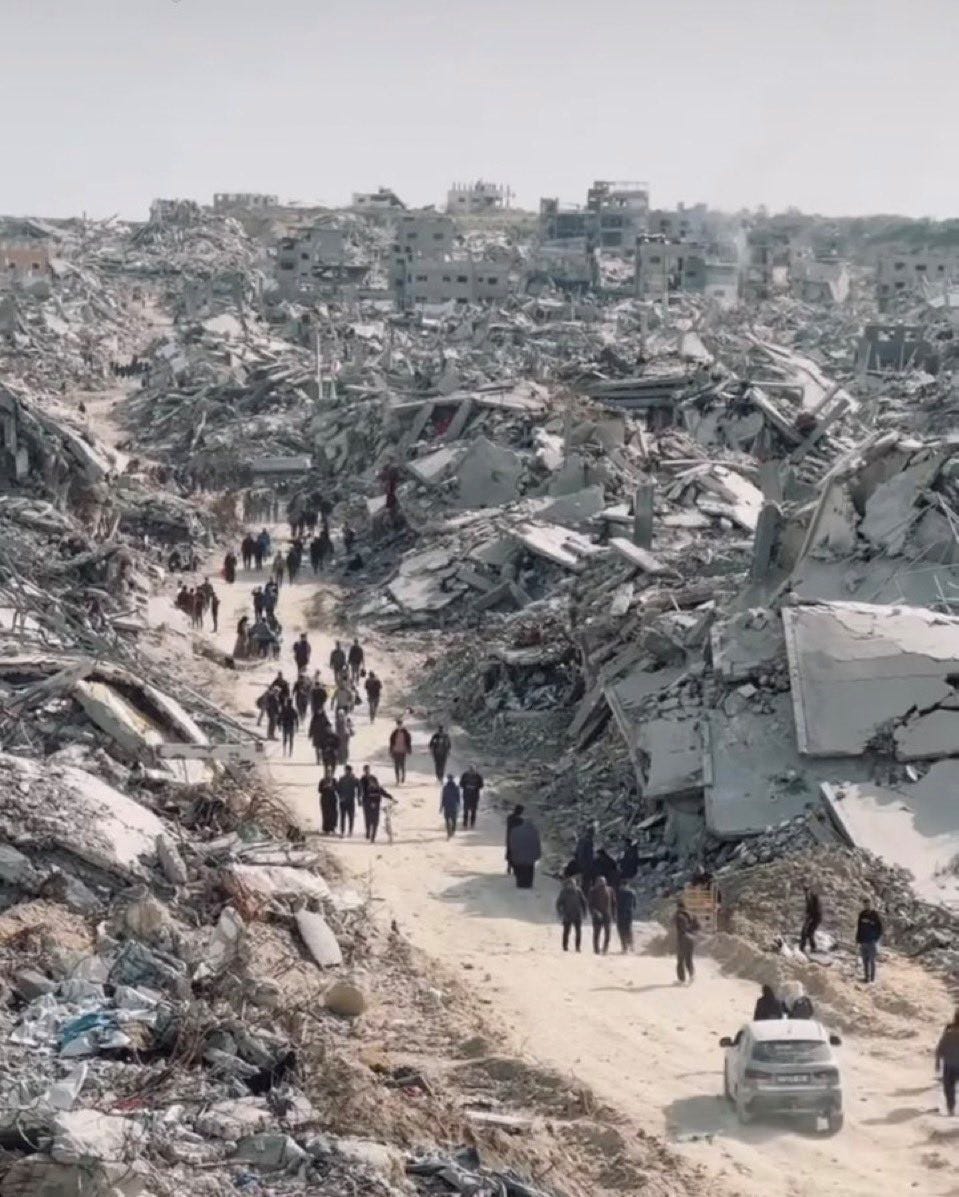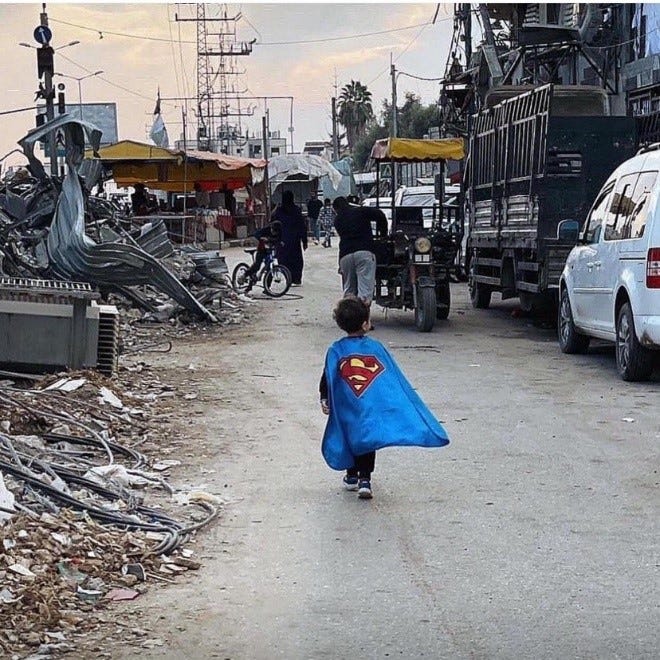Notes on the ceasefire
How did it come about? What does it mean? Will it hold? What happens next?
As the ceasefire in Gaza comes into effect, Palestinians have begun heading back to the wreckage of their homes, from Rafah in the south to the enclave’s far north. Their minds and bodies are scarred, and they have lost loved ones: at least one in 50 Palestinians in Gaza have been killed, the true figure is likely closer to one in 25. Amidst it all, fighters of Hamas’s armed wing parade the streets, embrace civilians and declare their victory.
Will it hold? The message from Israel is that the war will resume if Israel does not achieve its war aims during the phase of negotiations that will begin in a fortnight. That message could be little more than an effort by Prime Minister Binyamin Netanyahu to hold his coalition together for a few more weeks: a second extreme-right party will quit if the agreement’s second phase leaves Hamas in control of Gaza.[1]
U.S. President Donald Trump’s words contain some ambiguity, but imply that the war really is over. “This has to end,” he said Saturday, adding that Israel should nonetheless “keep doing what has to be done.”[2]
Make no mistake: Israel had every intention of ethnically cleansing and annexing the northern part of the Gaza strip, in what would have amounted to a permanent strategic defeat for the Palestinian national movement. The facilities the military had built for their soldiers, complete with a cafe serving Belgian waffles, were meant to be permanent. The ceasefire, if it holds, undoes all that. It would represent Israel’s failure to achieve a lasting victory, and the end of the Israeli right’s dream to resettle Gaza.
As it stands, Israel’s only strategic achievement from the past 15 months has been to establish a principle of deterrence: that Palestinian attacks at scale on Israel (at least those which target civilians) will be met with overwhelming, disproportionate violence against Palestinian civilians. It is the principle of collective punishment that has defined Israel’s strategic doctrine since the foundation of the state. In the recent words of one general, speaking in the context of strikes on Yemeni civilian infrastructure, the idea is that “there’s no organisation in the world responsible for territory that can’t be deterred.” Essentially: hit civilians hard enough, and the armed forces that move amongst those civilians eventually have to adjust their calculations.
Indeed, Gaza needs time to recover, clear the rubble, and rebuild. Hamas is acutely conscious that its critics in Gaza have been growing increasingly vocal, and the fabric of Gazan society is worn thin. Hamas therefore needs to solidify its political standing, and so is unlikely to mount ambitious attacks on Israel for some time. Their base won’t support it, given the consequences.
But if Israel was not able to effect a permanent, territorial defeat on Gaza under the propitious circumstances of the past 15 months – with the stark, emotive casus belli of the October 2023 attacks, and the most pro-Israel U.S. President in history – they never will be. This was their best chance, and they failed.
The United States and Joe Biden
U.S. public opinion is growing more sympathetic to Palestinians and less sympathetic to Israel. That will tend to limit Israel’s ability to repeat the performance of the past 15 months in future: without achieving independence from the U.S., the scope of their impunity, their freedom to practice the collective punishment of civilians, will tend to shrink.
This was the basic flaw in President Joe Biden’s strategy. To the extent his approach had any internal logic – however murderous – it was that by demonstrating that the U.S. would not constrain Israel, Arabs would have to adjust their calculations accordingly. The goal was surrender at gunpoint. But to have effect, such an approach would have to be durable in perpetuity. U.S. presidents would need to be willing to keep on serving impunity to Israel on a silver platter. In the event, that posture collapsed after 15 months, on first contact with an election. Israel’s brutality proved morally and strategically indefensible in the least liberal Western society; the result is that it has been brought to an end.
“Ending Israel’s violence in Gaza” was the top motivation for U.S. voters who switched from Biden in 2020 to someone other than Kamala Harris in 2024, and the second most important motivation in battleground states. By more than three-to-one those voters said they would have been more likely to vote for Harris if she had pledged to withhold arms from Israel. That should not have been a surprise.
When Biden was told in March last year that his poll numbers in two swing states were slipping over his handling of the war in Gaza, “He began to shout and swear . . . He believed he had been doing what was right, despite the political fallout, he told the group.” By then, both Democrats and independents were, on aggregate, less likely to support a candidate who continued to support Israel with military aid. Democratic strategists were baffled by the President’s chosen course.

Biden’s support for Israel was never primarily a matter of electoral advantage. His was an ideological fervour that defies reduction to either his own political interests or the national interest of the United States. As his ambassador to Israel put it, “Joe Biden is the last president of his generation, whose memories and knowledge and passion to support Israel go back to the founding story.”
In the foundational myth of the post-World War II liberal-international order, Israel represents the redemption of the Western world from the shadow of Nazism and the fire of the Holocaust. For many politicians of Biden’s generation, to turn on Israel was to call that redemption into question, and with it their entire worldview. But Israel’s overbearing strength and aggression has made other stories seem more relevant: about a system differentiated from apartheid mostly by its greater violence, and from 19th century settler colonialism mostly by its superior technology.
For a generation of politically engaged young Americans, the abiding image of Israel will be that of a boy with Downs syndrome mauled to death by an IDF dog. A seven-year-old girl, her legs shorn off, hanging dead from the wreckage of her home. A teenager burnt alive on a gurney as his father looked on, unable to help. A punishment rape in prison, captured on video behind a wall of riot shields. A six-year-old girl trapped in the wreckage of her car alongside her bullet-riddled family before she, too, was killed. Israeli soldiers prancing and rejoicing in the ruins. And the response of Israeli civilians, often, at best, “who gives a shit?”
Biden’s ambassador to Israel again identified the dynamic: “you can’t ignore the impact of this war on future policymakers — not the people making the decisions today, but the people who are 25, 35, 45 today and who will be the leaders for the next 30 years, 40 years.”
Hamas and the armed resistance
It was an irony of history that Israel’s war on Hezbollah lead to the ascendancy of a former Salafi jihadist in Damascus, whose nom de guerre implied that he one day hoped to retake the Golan Heights from Israel. It is no less ironic that, if the Gaza ceasefire holds, Donald Trump will have saved Hamas and the Palestinian armed resistance. The persistence of the group’s armed wing is impressive, given their vast disadvantage in technology. They never struggled for recruits. But they were never dangerous enough to the Israel Defense Forces to deter it from entering areas of Gaza at will. Very slowly, but surely, Hamas’s lethality was declining (see chart), and there was no meaningful pressure within Israel to end the war due to casualties.

It is unfortunately not true that “you cannot militarily destroy a freedom struggle.” Where are the Tamil Tigers (LTTE) now? The difference between the fortunes of LTTE and Hamas is that India was not prepared to intervene to put a stop to the Sri Lankan government’s 2009 offensive, but Donald Trump was prepared to put a stop to Israel’s. There is little doubt that the IDF could ultimately have defeated Hamas in any area which had been sealed from the rest of Gaza, and from which the civilian population was expelled.
When Israel withdraws, Hamas will again be the most powerful force within Gaza. But they may need to compromise with outside powers, including the U.S., over the provision of reconstruction assistance.
Israel’s physical devastation of Lebanon forced Hezbollah to give in to the appointments of its opponents as President and Prime Minister. That was the condition of funding for the reconstruction that their supporters demanded, and which sanctions-hit Iran was unable to provide. Unlike Hezbollah, Hamas in Gaza faces no alternative domestic centre of armed force, but the needs of its people are even greater.
The victory Hamas can claim is one of survival against incredible odds, in which the group’s tunnel network played a decisive role. But are Palestinians any closer to the goal agreed by all factions, including Hamas, of an independent state? Survival is not enough to force concessions: for all the furore on the Israeli right, unless something drastic changes, Gaza can be put back in stasis for a decade or two, while the theft of the West Bank and East Jerusalem continues.
The Palestinian national movement is in unprecedented territory. A new push for programmatic unity between the leaderships in Gaza and the West Bank is necessary. The West Bank leadership need to stop using Hamas as an excuse for quiescence, corruption and repression, and develop a political strategy to resist the occupation. Hamas needs to recognise that the strategic limits of the Gaza-based armed struggle have been reached for now.
The solidarity movements
The ceasefire was forced on Israel by the United States, not by the Palestinian armed resistance. This is a reminder that the Palestinian cause is not a military struggle with a political dimension. It is a political struggle in which military action sometimes plays a subordinate role. It is a struggle whose strategic fulcrum is state power in the United States and Europe.
What, then, of the grassroots movement against genocide on both sides of the Atlantic? The harsh reality is that the cumulative impact of all the demonstrations, all the blockades, all the acts of sabotage, all the encampments, on Israel’s military operations was approximately zero. There is no credible argument that they compelled the Biden administration to restrain Israel, nor that they were an important motivation for Trump’s decision. They helped some Palestinians feel less alone; a worthwhile objective, but not a sufficient one.
Nor is it clear that they did much to alter the general direction of public opinion, which appears to have been driven largely by the reality of what was happening in Gaza, as filtered through both legacy and social media. This is not to denigrate the courage and commitment of those who demonstrated, blockaded and so on, nor even to say, necessarily, that they could have achieved more. It is probably true that given Biden’s personal commitment to Israel, and his willingness to endure adverse electoral consequences for the sake of his preferred policy, it would have been extremely hard to do any better.
The point is, instead, to highlight the centrality of state power, and to encourage activists to recognise that it is necessary to make a long-term attempt to acquire it. In Britain, the battle to meaningfully influence the situation in Gaza was lost at the 2019 election. In the U.S., it was lost when Bernie Sanders withdrew from the 2020 race in favour of Joe Biden. The politics of state is decisive in international relations. Everything that does not lead to controlling it is a sideshow. That is why crank (or “tankie”) anti-imperialism, the selfish, performative politics of individual self-expression, and impotently cheerleading the armed resistance as a substitute for engaging with mainstream opinion are so corrosive. They are either useless to, or incompatible with, a serious political effort to protect people in Gaza.
Even if the ceasefire holds, Gaza needs continuing attention and solidarity. Videos of jubilant or defiant Palestinians returning home get good play on social media, but there are just as many people looking at the rubble of their homes in quiet despair. “The real war starts after the announcement of the ceasefire,” one friend wrote to me from his tent. “Cities of wreckage. No place to go.”
If you’re looking for a way to donate directly to Palestinians in Gaza, please consider supporting the family of my good friend Anees. (Alternatively, use Paypal, marking the donation for “Anees’s family”.) Anees has done a huge amount to help his fellow Palestinians in Rafah over the years, and he needs our help now.
[1] Prime Minister Netanyahu has also stated that, contrary to the written terms of the ceasefire agreement, Israel will increase its presence in the Philadelphi corridor.
[2] “The United States has to get respected again, and it has to get respected fast. But respect is the primary word that I use,” he continued, implying that he considered the credibility of both himself and the United States to be on the line. “If they respect us, it will hold. If they don’t respect us, all hell will break out.”





Sorry I’m shamefully behind on your writings. Thank you for including how difficult Biden made things, and opened the door for trump. Fantastic work as usual.
It's become a meme by now, but if you claim Israel's response is "overwhelming, disproportionate violence", it's only fair you offer an alternative? What would be a fitting response to a massacre so cruel where families are tortured on a Facebook livestream? When dead naked bodies of teenage girls are being lynched and spat on by civilians?